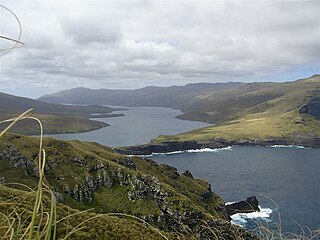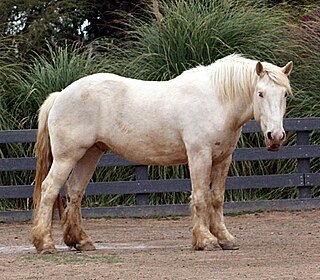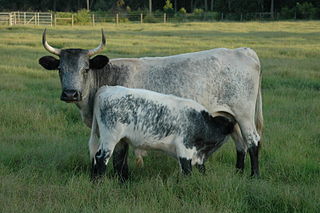
The Auckland Islands are an archipelago of New Zealand, lying 465 km (289 mi) south of the South Island. The main Auckland Island, occupying 460 km2 (180 sq mi), is surrounded by smaller Adams Island, Enderby Island, Disappointment Island, Ewing Island, Rose Island, Dundas Island, and Green Island, with a combined area of 570 km2 (220 sq mi). The islands have no permanent human inhabitants.

Auckland Island is the main island of the eponymous uninhabited archipelago in the Pacific Ocean. It is part of the New Zealand subantarctic area. It is inscribed in the UNESCO World Heritage list together with the other New Zealand Subantarctic Islands in the region.

The Longhorn or British Longhorn is a British breed of beef cattle characterised by long curving horns. It originated in northern England, in the counties of Lancashire, Westmorland and Yorkshire, and later spread to the English Midlands and to Ireland. It was originally a slow heavy draught animal; cows gave a little milk, although high in fat. In the eighteenth century Robert Bakewell applied his methods of selective breeding to these cattle, which for a short time became the predominant British breed. Both the numbers and the quality of the breed declined throughout the nineteenth century and for much of the twentieth. A breed society was formed in 1878, and a herd-book published in that year.

The Ponui or Ponui Island Donkey is a breed and feral population of domestic donkey from Ponui Island, in the Hauraki Gulf off New Zealand. It is the only feral donkey in New Zealand. It may also be called the New Zealand Donkey.

The Belted Galloway is a traditional Scottish breed of beef cattle. It derives from the Galloway stock of the Galloway region of south-western Scotland, and was established as a separate breed in 1921. It is adapted to living on the poor upland pastures and windswept moorlands of the region. The exact origin of the breed is unclear, although the white belt for which they are named, and which distinguishes the breed from black Galloway cattle, is often surmised to be the result of cross-breeding with the similarly coloured Dutch Lakenvelder.

Enderby Island is part of New Zealand's uninhabited Auckland Islands archipelago, south of mainland New Zealand. It is situated just off the northern tip of Auckland Island, the largest island in the archipelago.

The Tamworth is a British breed of domestic pig. It is the only red-coloured British pig. Its origins are unknown, but it appears to have developed near the town of Tamworth in south-eastern Staffordshire, close to Warwickshire border. It is one of seven British pig breeds listed by the Rare Breeds Survival Trust as 'priority', the highest level of concern of the trust.

The Livestock Conservancy, formerly known as the American Livestock Breeds Conservancy (ALBC) and prior to that, the American Minor Breeds Conservancy, is a nonprofit organization focused on preserving and promoting rare breeds, also known as "heritage breeds" of livestock. Founded in 1977, through the efforts of livestock breed enthusiasts concerned about the disappearance of many of the US's heritage livestock breeds, The Livestock Conservancy was the pioneer livestock preservation organization in the United States, and remains a leading organization in that field. It has initiated programs that have saved multiple breeds from extinction, and works closely with similar organizations in other countries, including Rare Breeds Canada. With 3,000 members, a staff of eleven and a 19-member board of directors, the organization has an operating budget of over a million dollars.
Enderby Island Cattle are a breed of cattle that existed in a wild state in isolation on Enderby Island, New Zealand for over 80 years. Only about seven specimens remain today, after a rescue expedition by the Rare Breeds Conservation Society of New Zealand (RBCSNZ), and a culling program to protect the native flora and fauna of Enderby Island. There have since been intensive efforts at breeding the cattle, involving both in vitro fertilisation and cloning, and there is an ongoing program to perpetuate the breed in captivity.

The Enderby Island Rabbit, or simply Enderby rabbit or Enderby, is a rare breed of domesticated European rabbit. It originates from rabbits introduced to Enderby Island, an uninhabited subantarctic island in New Zealand’s Auckland Islands group, from Australia in October 1865 to serve as castaway food. Over 130 years the isolated population became a distinctive variety. The rabbits were eventually exterminated for wildlife management from Enderby Island in the early 1990s, but a breeding group of 49 rabbits was rescued by the Rare Breeds Conservation Society of New Zealand in September 1992. Since then rabbit breeders have maintained numbers at around 100-150 individuals, primarily through the work of Sitereh Schouten and the Enderby Island Rabbit Club of NZ. They have ensured breed purity with pedigrees and ear tattoos which exclusively include a Z along with an individual number.

The Auckland Island pig is a feral landrace of domestic pig found on subantarctic Auckland Island, New Zealand. Its ancestors have inhabited the island since 1807, and, as an invasive species, has had a considerable environmental impact.
Campbell Island cattle were a feral breed of domestic cattle found on Campbell Island, New Zealand. From photographs taken in 1976 it appeared that the cattle were at least partly of shorthorn origin. This breed is now extinct.

In modern agriculture, a rare breed is a breed of poultry or livestock that has a very small breeding population, usually from a few hundred to a few thousand. Because of their small numbers, rare breeds may have a threatened conservation status, and they may be protected under regional laws. Many countries have organizations devoted to the protection and promotion of rare breeds, for which they each have their own definition. In botany and horticulture, the parallel to rare animal breeds are heirloom plants, which are rare cultivars.

The American Milking Devon is an American breed of dual-purpose cattle, reared both for milk and for beef. It derives from the Devon cattle of the United States, which in turn are derived from the North Devon cattle of south-west England. It was established as a separate breed in 1978 with the formation of the American Milking Devon Cattle Association, after the breeding aims of the Devon were concentrated almost exclusively on beef production. It is a rare breed: its conservation status is listed as by the Livestock Conservancy as 'critical'.

A castaway depot is a store or hut placed on an isolated island to provide emergency supplies and relief for castaways and victims of shipwrecks.

The Oxford Sandy and Black is a British breed of domestic pig. It originated in the county of Oxfordshire, and is named for that and its colour, which is a sandy brown with black patches. It is believed to be one of the oldest British breeds of pig.

The Florida Cracker or Florida Scrub is an American breed of cattle. It originated in Spanish Florida and later in the American state of Florida, and is named for the Florida cracker culture in which it was kept. It is one of the Criollo breeds that descend from the Spanish cattle originally brought to the Americas by the Spanish Conquistadors; among the other North American breeds in this group are the Pineywoods, the Corriente and Texas Longhorn. Unlike the Pineywoods – to which it is closely related – the Florida Cracker has not been inter-bred with breeds of North European origin.
The American Breed is an American bovid hybrid of cattle with a small percentage of American Bison blood. It was developed in the 1950s by a New Mexico rancher looking for beef cattle which could survive on poor fodder in the arid Southwest.

The Hereford Hog or Hereford is an American breed of domestic pig. It is named for its color and pattern, which is similar to that of the Hereford breed of cattle: red with a white face.
















